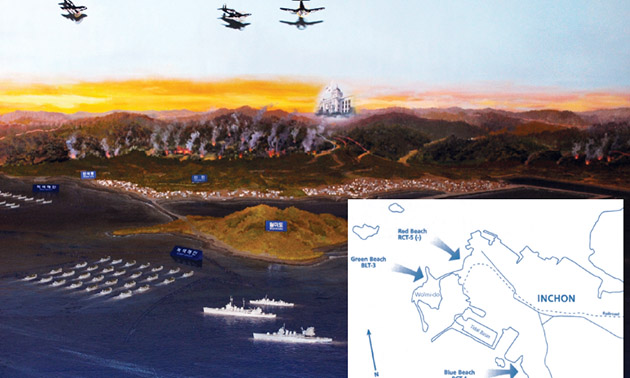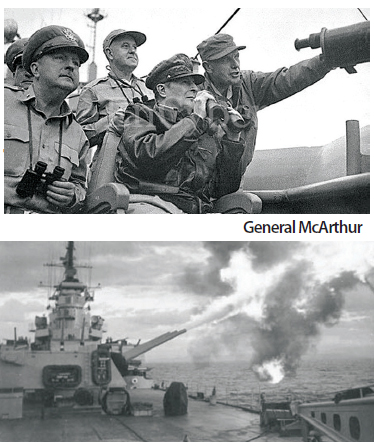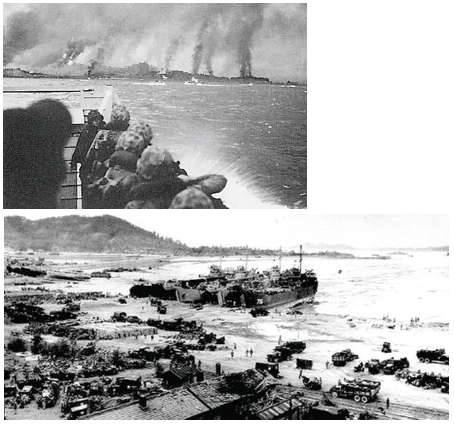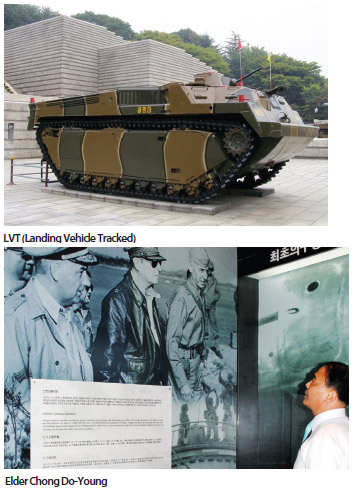|
|
Remembrance is the secret of redemption
|
|
|
글쓴이 :
관리자
|
|
A look at Korea’s modern history that progressed under the guidance of God (5)
Remembrance is
the secret of redemption
The scene of the Incheon Landing Operation
On the second-floor exhibition hall at the Yad Vashem Holocaust Museum in Israel, there is a copperplate with an inscription that says, “Forgetfulness leads to exile, while remembrance is the secret of redemption.” The Republic of Korea has a special day to remember in the month of June. It is also why the South Korean government designated the month of June as the month to remember our veterans and patriots. In the early morning of June 25th, 1950, North Korea provoked the Korean War by invading the South. The war ended on July 27th, 1953, after both sides agreed to sign the armistice. However, the war left one of the biggest scars the land of Korea has ever seen in her entire history. It has been almost 60 years since the war, but Korea is still in a state of armistice; the war is not over. Nevertheless, the Korean War has been forgotten among the younger generation these days. I have visited the actual battle field where our parents’ or our grandparents’ generation must have fought fiercely when they were younger. I was accompanied by Elder Chong Do-Young (The Army Military Academy 34th Class, former 5th Corps Assistant Chief of Staff for Operations, former instructor for the Army Staff College, expert in war history, currently working at the Ministry of Land, Transport and Maritime Affairs) to Incheon where the Incheon Landing Operation was carried out. The Incheon Landing Operation is considered one of the greatest military operations in the history of war. It struck a decisive blow to the North Koreans, reversing the tides of battle, and revived the South that was at the verge of destruction.

The situation of South Korea right before the Incheon Landing Operation
Incheon is located about 30 km away from Seoul and an hour away from the sea. Before we went to the shore where the Incheon Landing Operation was carried out, we dropped by The Memorial Hall for Incheon Landing Operation located in Okryeon-Dong, Yeonsu-Gu, Incheon. The memorial hall was opened in 1984 and exhibits various kinds of historical material related to the Incheon Landing Operation.
“The Incheon Landing Operation was the most dramatic operation in the history of wars around the world. Some might compare it with the D-Day invasion of Normandy during World War II; but the Incheon Landing Operation was far more effective considering the impact it had on the entire war. In the case of D-Day, it took more than a year to suppress the German forces even after the success of the invasion. However, the Incheon Landing Operation, in just eight days, caused the collapse of the North Korean forces, which had penetrated deep into South Korean territory. When North Korean forces retreated from the Pusan Perimeter (Nakdong River Front), they did not pull back in an orderly manner. In an instant, they lost the form of an army. Simply put, they were scattered into all directions.” (Elder Chong Do-Young)
The Memorial Hall for Incheon Landing Operation contained many exhibits that showed the situation of South Korea right before the landing operation. The most impressive among them was a map that showed the situation just eight days prior to the amphibious operation. It indicated the final line of defense in South Korea at the Pusan Perimeter (Nakdong River) where they were facing the North Korean forces in front, with only a portion of southern Gyeongsang Province remaining behind them.
“On September 6th, the 15th Division of the North Korean forces occupied Youngcheon. It took them only 40 days to advance 400 km south since June 25th. That means 90% of South Korean territories were lost. As a matter of fact, Walton Harris Walker, then the 8th Army Commander, even made a plan to evacuate only around 100,000 key South Korean figures to Guam. At that time, many Christians gathered at Kudeok Sports Stadium in Pusan and prayed earnestly. They prayed, begging for their lives; otherwise, they had no other choice but to drown themselves in the coasts of Pusan. In other words, South Korea was on the verge of complete extermination, a critical national emergency.” (Elder Chong Do-Young)
It was then that God surely gave His helping hand towards South Korea. On September 12th, South Korea was able to recover the main defense line at Nakdong River after making a dramatic victory at the Youngcheon battlefield.
“In 1950, Nakdong River suffered the worst drought in 30 years, causing the water level to be only about one to one and a half meters deep. It was shallow enough for people to cross the river on foot. However, North Korean forces were unable to penetrate the Nakdong River defense line. The defense line was only about 100 km away from Pusan. Realizing that it was the opportunity to end the war, North Korea commenced a full attack on South Korea and the UN allied forces. However, South Korea and her allies burned all bridges behind them and blocked North Korea from achieving its goal. God protected South Korea by enabling them to stop the North Korean forces from penetrating the defense line. Had the Nakdong River defense line been penetrated, the Incheon Landing Operation would have been meaningless.” (Elder Chong Do-Young)
When we came out of the memorial hall, we saw a replica of the LVT (Landing Vehicle Tracked) on the front yard. LVT is an amphibious tracked vehicle that landed on the shores of Incheon during the Incheon Landing Operation. The parking lot was filled with buses that transported elementary students visiting the Memorial Hall for a field trip. We proceeded towards Incheon beach.

Green Beach, Red Beach, and Blue Beach
During the Incheon Landing Operation, 75,000 soldiers and 261 battle cruisers landed on the beaches of Incheon, recapturing Seoul and cutting off the supply route of the North Korean forces. At the same time, the allied forces launched a counterattack at the Nakdong River defense line, reversing the tides of the war to their favor. The amphibious attack was planned by General McArthur and was named “Operation Chromite.” In the beginning, however, General McArthur faced strong opposition to his plan from The United States Joint Service Command and The Far East Naval Command. It was because of the unfavorable, natural conditions of the Incheon shore, which included narrow channels, limited approach roads, tides that were the second-highest in the world, and a fortified Wolmido Island. Such unfavorable conditions of the beaches made the landing difficult. The operation’s possibility of success was only 1 in 5,000. On August 23rd, a United Nations Command conference was held in Tokyo. An American Army Chief of Staff (Collins), Chief of Naval Operations (Sherman), United States Marine Corps leader, and others were gathered. They were dead set against the plan, and insisted on landing in Gunsan or Asanman instead. However, General MacArthur didn’t change his plan and carried it out after making a 45-minute long extemporaneous speech, which persuaded the participants of the conference.
“The North Koreans think that the shores of Incheon are impossible to land on. We need to use this fact to our advantage to achieve the element of surprise. We must land in Incheon so that in Seoul, the capital of Korea, we can prove to the world that justice and liberty still exist” (from General MacArthur’s speech).
Incheon’s outer harbor was too narrow for a large-scale fleet with sufficient firepower to anchor down in. It was also unsuitable for unloading a sufficient number of troop reinforcements. Nevertheless, there were three shores in which landing was possible: they were respectively named “Green Beach,” “Red Beach,” and “Blue Beach.” Also, landing was only possible during the high tide times, which were three hours starting at 6:30 AM or three hours starting at 5:30 PM. In the initial stage, the 3rd Battalion of the 5th Marines landed on Green Beach with nine tanks at 6:33 AM on September 15th, 1950. By 8 AM, they had taken full control of Wolmido Island.
“Wolmido Island is the gateway to Incheon. Around 400 of the North Korean soldiers were standing their ground in caves or other strongholds they had created. Nevertheless, we bulldozed over them with tanks and were thus able to gain control of the island. In capturing the North Koreans, there were some who became mentally deranged due to the sounds of the bombing. During the landing operation, bombers and battleships poured a barrage of bombs and cannons on Wolmido Island starting from September 13th.” (Elder Chong Do-Young)
The second stage of the landing operation took place during the evening high tide. At 5:33 PM, the 1st and 2nd Battalions of the United States 5th Marines as well as the 3rd Battalion of the Republic of Korea Marine Corps (ROKMC) landed on Red Beach while the 1st, 2nd, and 3rd Battalions of the 1st US Marines landed on Blue Beach.
“To set the stage for the landing during the evening high tide, the battleships started their barrage of bombardments at 2:30 PM. They say that the beaches were covered with over 500 landing crafts and LVTs. The 5th Marines landed at Red Beach and headed for Eung-Bong Mountain while the 1st Marines, which had landed at Blue Beach, attacked Su-Bong Mountain. Finally, the 2nd Battalion captured Su-Bong Mountain, thus taking control of the Seoul-Incheon Highway that leads to Seoul. At that time, communication lines were cut and because of severe pollution, they say that there was much confusion.” (Elder Chong Do-Young)
It was not an easy task finding the monuments erected on the three beaches where the landings took place. Excepting the Green Beach on Wolmido Island, both the Red Beach and the Blue Beach have been turned into roads as part of the coastal reclamation project. In contrast to the relative grandeur of The Memorial Hall for Incheon Landing Operation, the monuments were shabby little installments on the side of the road.
“At this rate, it will get more and more difficult to find. These are significant items that need to be preserved so that our descendants can clearly remember the painful past. This is quite sad.” (Elder Chong Do-Young)

Incheon Bridge and the Palmido Lighthouse
You can see the Incheon Bridge from the coasts of Wolmido Island. On a clear day, even the Palmido Lighthouse can be seen. The 21.38 km-long Incheon Bridge is erected atop the beach where the Incheon Landing Operation took place. Palmido Island is on the other side of the Incheon Bridge. As the very first lighthouse in Korea, the Palmido Lighthouse is located at the corner where the southwest seas enter into the Incheon coasts; thus, it guides the ships that enter the Incheon harbor.
“At 00:12 on September 15th, the KLO Unit (Unit Commander Choi Gyu-Bong) recaptured the Palmido Lighthouse. They then lit up the beacon and guided the allied forces into the harbor, effectively starting the Incheon Landing Operation. The fleet of the UN Forces, following the light from the lighthouse on the early morning of the 15th, was now able to carry out the Incheon Landing Operation.”
Su-Bong Mountain and Eung-Bong Mountain
The 1st Marine Regiment, which landed on Blue Beach, attacked and captured Su-Bong Mountain. Currently, Su-Bong Park is located on Su-Bong Mountain and the Monument Inscription of Incheon is also there.
“Su-Bong Mountain was captured in order to get control of the Seoul-Incheon Highway. The bridgehead to Seoul was secured because the 1st Marine Regiment landed on Blue Beach and captured Su-Bong Mountain, and the 5th Marine Regiment landed on Red Beach and captured Eung-Bong Mountain. All the supplies and troops delivered to the North Korean forces standing ground at the Pusan Perimeter (Nakdong River Front) went through Seoul to get to them. When our troops landed in Incheon and recaptured Seoul, it was a decisive blow to the hearts of the North Koreans. And this was the reason why General MacArthur insisted on doing this. Going through Gunsan or Asan would not have been a decisive blow because it would not have inflicted enough damage to the North Korean forces at the Pusan Perimeter.” (Elder Chong Do-Young)
Eung-Bong Mountain was captured by the 5th Marines Regiment, which had landed on the Red Beach. MacArthur’s statue is located in the Freedom Park at Eung-Bong Mountain.
“General MacArthur was a premier soldier. He graduated at the top of his class from West Point and was an expert on the Far East. He retired in 1937 but when World War II broke out, he returned to active duty in 1941. Then, as the Supreme Commander of the Southwest Pacific Area, he received the surrender of the Japanese. He was a man who was prepared for the Korean War. He was able to protect the Republic of Korea from communism because of his strong belief in democracy. I believe that God had used General MacArthur as His tool to protect South Korea. In order to evade an all-out war with the Soviet Union or China, the United States made it a matter of policy to impose restrictions on the war. But MacArthur opposed this policy by crossing over the 38th parallel and advancing all the way to the Yalu River. And even after the entrance of China’s involvement in the war, MacArthur ordered full forward advance so that the war could come to an end. Then, in April of 1951, he was discharged.” (Elder Chong Do-Young)

God who helped the landing operation to succeed
As I explored around Incheon and visited the very locations where the Incheon Landing Operation took place some 62 years ago, and as I listened to Elder Chong’s explanations, I was able to feel even more strongly the helping hand of God in the success of the landing operation. In order for a ship to come ashore, there needs to be at least 7-8 meters of water depth. In the coasts of Incheon, such depths were available only for four days during the year, starting from September 15th. Not only that, even during those four days, the necessary conditions were available only for three hours during the morning high tide and three hours during the evening high tide. Even under such terrible conditions, when all other commanders in the US military were adamantly opposed to the idea, General MacArthur insisted on going through with the operation. It was General MacArthur who had convinced General Walker, the commander of the Eighth US Army. Walker was opposed to the idea of sending the Fifth Marines Regiment from the Pusan Perimeter to Incheon for fear of losing even the Pusan area to the North Koreans.
“It wasn’t that they had troops to spare at the Pusan Perimeter. Sending the Fifth Marines Regiment to Incheon would put them in a very vulnerable position. Thankfully, they were able to recapture Youngcheon just three days prior on September 12th, and MacArthur’s insistence was accepted. The North Korean’s miscalculation also played a role. China’s Mao Zedong had warned Kim Il Sung that MacArthur was a genius at landing operations and to be mindful of Incheon. But Kim Il Sung did not listen. He thought that a bit more push at the Pusan Perimeter would bring the war to a close.”
Kim Il Sung poured all of his strength into the Pusan Perimeter. He left only the security forces in the Seoul and Incheon areas while all the battle forces were injected into the Pusan Perimeter. After the landing operation succeeded on September 15th, at midnight on September 16th, the Korean and UN forces at the Pusan Perimeter were given orders to counterattack. As news of the landing operation reached the North Korean forces, the tides quickly turned. The North Korean forces had been defeated psychologically. Just eight days after the landing operations, on September 23rd, Kim Il Sung ordered a full retreat of his forces.
“The scariest news to the soldiers fighting on the battlefield is to hear that the enemy has infiltrated their rear. When they heard that their rear was compromised, the North Koreans fell into chaotic disarray. With the order of a full retreat, entire battalions soon dispersed.” (Elder Chong Do-Young)
God’s grace comes from unexpected places. Back then, at the Kudeok Stadium in Pusan, they were most likely praying for victory at the Pusan Perimeter. However, victory came unexpectedly from Incheon. God, who had parted the Red Sea for the Israelites, opened up the Incheon coastline for the Republic of Korea.
“But from a soldier’s perspective, there’s something very strange. The UN forces that landed on Green Beach at the morning high tide were merely 500 soldiers in strength. The rest had to wait for the evening high tide. But what were the North Korean forces doing during that time? If they had wanted to, they could have wiped out the UN forces that had landed at Wolmido Island. The North Korean forces stationed at Kimcheon and Waegwan were injected into Incheon on September 18th and 19th. God had surely helped this operation to succeed.” (Elder Chong Do-Young)
The beaches on that day were filled with booming sounds of gunfire and bombs. But now, its appearance has drastically changed as the Incheon Bridge and Songdo International City greets the West Sea. Of course, the rapidly developing nation is a source of pride; however, are we forgetting about the beaches back then too rapidly? The shabby monument standing by the side of the road really bothers me.
“Ever since I became a soldier, I was always interested in war history. That is why I studied it so diligently. I especially believe that the Incheon Landing Operation is the greatest military operation to go down in history. I was thrilled to come and visit the locations directly. I was once again reminded of God’s grace.” (Elder Chong Do-Young)
We left Incheon Freedom Park and headed for Seoul. We drove down that highway toward Seoul, the same highway that the South Korean and UN forces fought fiercely over on that very day some 62 years ago. As I thanked God for planning and carrying out the successful Incheon Landing Operation, the drive down that highway seemed much shorter than usual.
“The Lord will fight for you while you keep silent” (Exod 14:14).
Written by reporter Suh Jung Hwa
|
|
|
|
|
|

